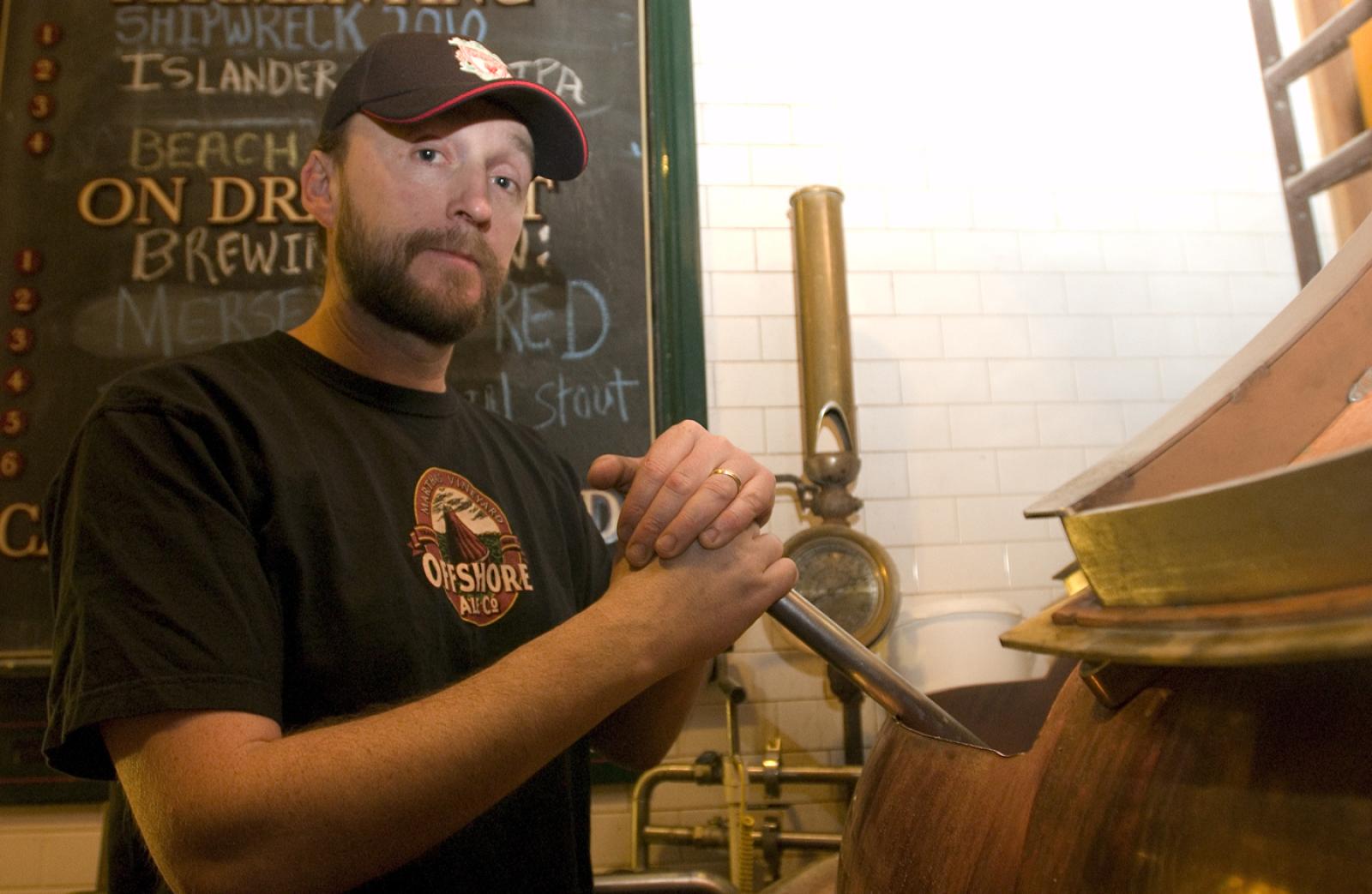There were two competing lively scenes at Offshore Ale Company’s fifth annual brewery open tour on Saturday. While Good Night Louise carried patrons to the tipsy twilight hours with jam band standards, upstairs an even wilder party raged within the walls of the brewery’s fermentation tanks. Here yeast organisms were reproducing, by the hundreds of millions, gorging themselves on sugars and excreting carbon dioxide and alcohol. And though the brewery tour only lasted until the early evening this party will last for weeks.
Although beer was originally created by happy accident in Mesopotamia thousands of years ago, brewing has since become a hard science — a mix of microbiology, thermodynamics, biochemistry and hydraulics. It’s therefore no surprise that in a former life head brewer Neil Atkins worked as a microbiologist at the Fred Hutchinson Cancer Research Center in Seattle. Despite the carpet of discarded peanut shells and the atmosphere of rustic abandon at Offshore, a veritable laboratory exists behind the scenes, which Offshore faithful had the opportunity to explore this past Saturday to discover what goes into their loudmouth soup.
Like any brewery, Offshore’s beer starts with malted barley, handfuls of which Mr. Atkins offered to his tour groups for munching. Offshore uses American, English, German and Belgian variations of barley depending on the beer.
“This one is roasted a bit more so it tastes chocolately — kind of like coffee,” he said chewing on the chaffy cereal grains. “Put one or two pounds of that in a beer and it will make it as dark as a stout.”
First, malted barley is mixed with hot water in the mash lauter (one of the iconic copper tanks that loom over diners and drinkers at Offshore). Here enzymes come alive to convert carbohydrates to simple sugars, which will later serve as fuel for the yeast in its heroic task of creating alcohol and carbonation.
“This is the most important part,” said Mr. Atkins. “If you get the temperatures wrong here you’re going to have a terrible beer.”
After an hour in the lauter it’s time to vorlauf the wort (a side effect of taking brewery tours is feeling as though you’ve just completed an introductory German course). Wort is essentially the sugar water later used to make beer, and vorlauf is a process of extracting wort from the mash, leaving the grains on the bottom of the tank to filter the wort as it drains out. From there it is sent to the kettle for the next step: the boil.
While it is boiling, hops are added to the wort (earlier for more bitterness and later for more aroma). Different beers also require different boiling times: the pungent favorite Hop Goddess requires 90 minutes while the high octane Barley Wine and Inkwell brews can take up to three hours.
Finally, after a spin in a whirlpool to separate proteins and hop particles from the wort, the concoction is sent to the fermentation tanks where it is stored at anywhere from 50 to 80 degrees, again depending on the style.
“Temperature,” Mr. Atkins sternly warned again, “Temperature control is the key to brewing.”
When yeast and oxygen are introduced to the tanks the microscopic party officially kicks off. Within an hour or two fermentation starts as yeast reproduces and creates alcohol and carbon dioxide, as much as the available supply of sugar and oxygen will allow. For his most recent creation, the Argus, a formidably dark Belgian ale, Mr. Atkins added Belgian candy sugar, which kicked the alcohol content up to a whopping nine per cent.
Except for the American-style East Chop Lighthouse, Mr. Atkins does not filter his beers. “People who drink East Chop Lighthouse expect it to be light,” he says.“The beer is forced through cellulose pads and it comes out nice and shiny, but filtering also strips the beer’s flavor.”
While mass-market beers — most of which, despite their agrarian barley-based marketing campaigns, are fermented from rice — trumpet their advanced filtering techniques and “drinkability,” Mr. Atkins traffics in the fruits of centuries-old brewing traditions and choice ingredients.
At the end of the tour I tried a glass of the hoppy Menemsha Creek Pale Ale and then one of the more intimidating offerings, the powerhouse 9 per cent Argus brew, which mercifully came served in a smaller wine glass. It was complex, malty and surprisingly friendly, and after a few enthusiastic sips came the familiar rush of endorphins and the compulsion to talk about nothing in particular.
“I fermented it at 80 degrees which makes the yeast more active,” Mr. Atkins explained. “It gives it more alcohol and it also gives it a whole bunch of interesting banana ester aromas.”
For the same reason that lunch meat spoils out of the refridgerator so does a warmer fermentation temperature increase the microbiological activity in Mr. Atkins’ brews.
“You have to control the temperature,” he said. “If you don’t, stuff will go wild.”





Comments
Comment policy »